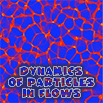Speaker
Prof.
Charles R. Doering
(University of Michigan)
Description
Mixing passive tracers by stirring in a fluid can be measured in a
variety of ways including particle dispersion, via the flux-gradient
relationship, or by suppression of scalar concentration variations
in the presence of inhomogeneous sources and sinks. The mixing
efficiency or efficacy of a particular flow is often expressed in
terms of enhanced diffusivity and quantified as an effective
diffusion coefficient. In this work we compare and contrast
several notions of effective diffusivity. We thoroughly examine
the fundamental case of a steady sinusoidal shear flow mixing a
scalar concentration sustained by a steady sinusoidal source-sink
distribution to explore apparent quantitative inconsistencies
among the measures. Ultimately the conflicts are attributed to
the noncommutative asymptotic limits of large Peclet number
and large length-scale separation. We then propose another
approach, a generalization of Batchelor's 1949 theory of diffusion
in homogeneous turbulence, that helps unify the particle
dispersion and concentration variance suppression mixing
measures.

